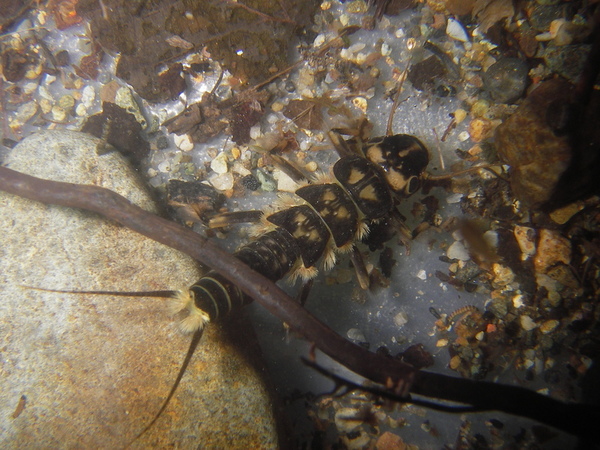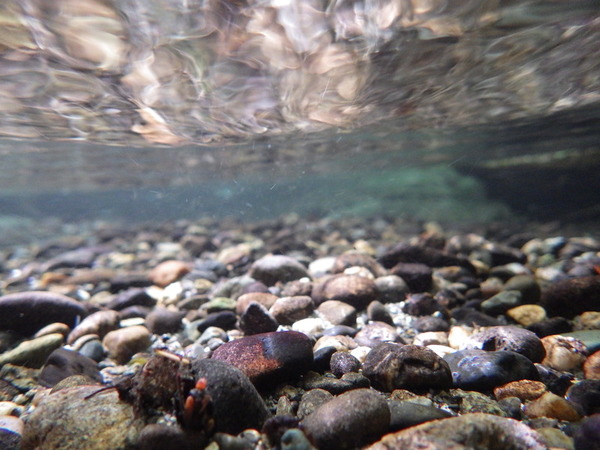What are benthic macroinvertebrates?
What kinds of organisms are they?
These organisms are often referred to as “stream bugs". But what are they really?
Aquatic insects.
Most benthic macroinvertebrates that we collect are insects in early stages of development. They spend most of their lives underwater as larvae. When aquatic insects reach adulthood, most types grow wings and no longer live in the stream. But they usually live nearby so that when the time comes to deposit their eggs, they can do so in the same water. Caddisflies, stoneflies, and mayflies are examples of these kinds of aquatic insects.
Other benthic macroinvertebrates.
Other benthic macroinvertebrates spend their entire lives in the water. These include snails, clams, and crustaceans.
Scientists call a single type of macroinvertebrate a taxon. The plural of taxon is taxa.

Why are they good indicators of stream health?
Many benthic macroinvertebrates live a year or more and don't move very far as larvae. As a result, they experience a range of seasonal conditions in the streams where they live. If conditions are usually good, sensitive taxa are more likely to survive in the stream. Sensitive taxa are less likely to survive when conditions have been bad for even a brief period.
Pollution tolerance.
Some benthic macroinvertebrates are tolerant of pollution (such as aquatic worms). Other taxa are sensitive to pollution. The presence or absence of both tolerant and sensitive taxa is important information. With it, scientists can better understand the condition of the stream. For example, many types of mayflies are very sensitive to pollution. As a result, the absence of mayflies in a stream can signal a problem.
Water and habitat quality.
Benthic macroinvertebrates experience a variety of other stressors besides pollution. The amount of fine sediment on the stream bottom can impact the stream community. How "flashy" a stream is during storm events can impact stream communities too. So can elevated water temperatures. Some benthic macroinvertebrates can tolerate some of these stressors better than others. Knowing these differences help scientists better understand the health of a stream.
Where do they live?

Stream bottom habitats.
Benthic macroinvertebrates have many different lifestyles. Because of this, a diverse community requires diverse conditions throughout a stream habitat. Streams include different habitat types such as riffles, runs, glides, and pools. Different benthic macroinvertebrates need the different microhabitats each of these provide. Some taxa need the clear, cold, fast water found in headwater streams. For example, benthic macroinvertebrates such as mayfly larvae can cling to rocks. They live in riffles where the water is fast and turbulent. Other taxa need deep, slow, warmer reaches. Aquatic worms are often found in the bottom of pools where fine sediments accumulate.
Why are they important?
Benthic macroinvertebrates are good indicators for biologists who are studying stream health. They also play a very important role in the stream ecosystem. They are an important link in the food chain as prey items for fish, birds, and other predators. They are also break down leaves and wood into smaller sizes that other organisms can use.
What do they eat?
Each taxon has its own specific role in the ecosystem determined by the way it feeds. Scientists can categorize benthic macroinvertebrates into groups called functional feeding groups. Taxa in similar functional feeding groups are often found in similar habitats. Some taxa prefer fast-moving riffles, others prefer slow-moving pools or other habitat. A complex and healthy ecosystem supports a variety of functional feeding groups.
Scrapers get food by scraping algae off rocks and other hard surfaces in the stream channel. Scrapers live in parts of streams where sunlight can reach the bottom to allow algal growth. These areas are often in shallow, fast-moving riffles. As a result, many scrapers have adapted to stay attached to rocks in fast currents. Scrapers may include snails, certain mayfly larvae, and limpets.
Shredders feed on leaves, twigs, and other pieces of organic matter that fall into a stream. They need lots of trees overhead (a dense canopy cover) to supply these materials. Shredders chew up the debris into smaller particles. These smaller particles then become a source of food for Collectors. Shredders include stonefly larvae and scuds. The caddisfly larvae pictured above is another example of a shredder.
Collectors eat fine organic matter. This includes leaf fragments, bacteria, fine sediment, and waste products from other organisms. There are two categories of collectors: filtering and gathering. Filtering collectors feed by filtering food out of passing water. They do this with hair-like fans or by spinning a fine net. Gathering collectors feed by gathering food from the bottom. Collectors are most common in slower-moving, low gradient streams where sediments collect. Even so, Collectors live in all types of stream reaches. Collectors include worms, blackfly larvae, and many mayfly and caddisfly larvae and midges.
Predators eat other macroinvertebrates and even fish. Predators can live anywhere in a stream but are less abundant than other feeder types. There must be enough prey to support predators, or they will not be present at all. Predators include the larvae of dragonflies, damselflies, and dobsonflies, among others. Adult aquatic beetles are predators. The larvae of some beetles, flies, stoneflies, caddisflies, and mayflies can be predators. But those taxa contain other functional feeding groups as well.

 Translate
Translate